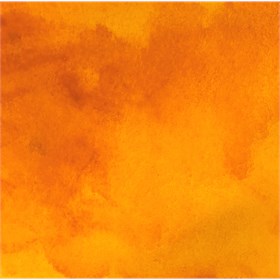I love watercolors.
They're just my type of thing.... One of the first colors I fell in love with was Indian yellow. It took me a while to learn the origins of one of my favourite pigments. And what an interesting story I found.

Indian yellow first originated in India in the 15th century, where it was known as piuri or purree.
The colour was found to have an unusual orange-yellow tone and an optical luminescence that resisted fading and seemed to brighten in sunlight. It became popular in India for painting Rajput-style miniatures and frescos, for dying cloth and colouring the walls of houses.
The pigment was soon imported into Europe and popularised by Dutch painters, including Jan Vermeer, who enjoyed the unique lightfastness of this extraordinary yellow. Indian yellow became part of JMW Turner’s watercolour palette and later the Scottish Colourists adopted it in oil form. One of its most famous users was Van Gogh, who painted a luminous Indian yellow moon in his 1889 masterpiece, The Starry Night. But this was one of the last sightings of the colour: in the early 20th century Indian yellow disappeared from the market in mysterious circumstances, which brings us to an interesting story.
The origins and components of Indian yellow were largely unknown at the time. For years, soft yellow lumps had been arriving in sealed packages at the London docks from Calcutta in India – some addressed to Messers Winsor & Newton. The dirty yellow balls would be washed and purified, and the greenish and yellow phases separated. The precise ingredients of these lumps were not known, but they had a strong odour of ammonia and were suspected of containing snake urine or ox bile, or, in the more popular theory, camel urine.
In 1883 Sir Joseph Hooker, the explorer, botanist and director of Kew Gardens, tried to get to the bottom of the mystery and wrote a letter to the Indian Department of Revenue and Agriculture to ask about the pigment’s source. Many months later he received a reply from a Mr TN Mukharji who wrote that in Mirzapur, Bengal, he had witnessed a group of cowherds (gwalas) feeding their cattle mango leaves and water, so that their urine would turn a very bright shade of yellow. He noted that the cows “looked very unhealthy” and undernourished. Their urine was collected, boiled and strained to produce a dirty yellow sediment that was then rolled and packaged off to London.
Mukharji’s letter was published in the Royal Society of Arts Journal and soon after the pigment disappeared from the market – rumoured to be as a result of animal cruelty protests that led to a law forbidding further production. Interestingly, mango leaves are known to contain the toxin urushiol, which is also found in poison ivy. At the time, Hooker had a sample of the pigment examined by the chemist Carl Gräbe.
The strange part of the story is that no trace can be found of the law, or the history of the pigment before the 1900s, except for Mukharji’s letter. Some say it may have been a hoax, although this is unlikely. There have been many investigations into the matter since. In 2002 the writer Victoria Finlay retraced the steps of Mukharji to Mirzapur, but found no evidence of the pigment. A 2018 publication investigated the original Carl Gräbe chemical analysis, confirming the animal origin of the sample and identifying the source as urine, based on the presence of hippuric acid, which is a key marker.
Nugget-like lumps of the original Indian yellow pigment can be found in the Winsor & Newton archive, and helped our chemists to develop a colour of similar lightfastness and intensity in 1996. Available in our oil and watercolour ranges, the new Indian Yellow is a warm golden yellow with excellent transparency – a staple colour in any artist’s palette and a glazing essential.
Luckily, the one I fell in love with and used for last 20ish years is the the new Indian Yellow... No cows molested...
source: https://www.winsornewton.com/uk/articles/colours/spotlight-on-indian-yellow/
Hi! I am a robot. I just upvoted you! I found similar content that readers might be interested in:
https://www.winsornewton.com/uk/articles/colours/spotlight-on-indian-yellow/
thanks Mr. Cheetah our AI sentinel but I already linked the article to the source :)
Wait.. I am talking to a Ai... Hahah.
Congratulations @chomuc! You have completed the following achievement on the Hive blockchain and have been rewarded with new badge(s) :
You can view your badges on your board And compare to others on the Ranking
If you no longer want to receive notifications, reply to this comment with the word
STOPDo not miss the last post from @hivebuzz: